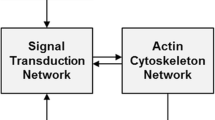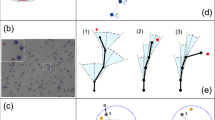Abstract
The signal that governs the chemotactic response of mammalian white blood cells and tissue cells arises from membrane-localized binding events involving chemotactic factor ligands and receptors and G proteins. Fluctuations in this signal have been traditionally attributed to significant “noise” in receptor-ligand binding owing to a limited number of receptors. This paper examines the validity and consequences of a new hypothesis which states that the noise could be associated with a limited number of G proteins as well as receptors. This work characterizes via stochastic analysis and simulation the effects of the relative sizes of G protein and receptor populations on the variance of fluctuations of receptor states and consequently on the directional persistence behavior of cells in uniform chemotactic factor concentrations under the assumptions of the model used to link a G protein-mediated receptor signal to cell turning. Our results suggest that there may exist an optimal number of G proteins through which chemotactic receptors can signal that maximizes cell orientation accuracy in a chemotactic factor gradient.
Similar content being viewed by others
References
Berg, H. C., and E. M. Purcell. Physics of chemoreception.Biophys. J. 20:193–211, 1977.
Becker, E. L., J. C. Kermode, P. H. Naccache, R. Yassin, M. L. Marsh, J. L. Munoz, and R. I. Sha'afin. The inhibition of neutrophil granule enzyme secretion and chemotaxis by pertussis toxin.J. Cell. Biol. 100:1641–1650, 1985.
Cumming, I. G. Derivation of the moments of a continuous stochastic system.Int. J. Control 5:85–90, 1967.
Fay, S. P., R. G. Posner, W. N. Swann, and L. A. Sklar. Real-time analysis of the assembly of ligand, receptor, and G protein by quantitative fluorescence flow cytometry.Biochemistry 30:5066–5075, 1991.
Gardiner, C. W. Handbook of Stochastic Methods. New York: Springer-Verlag, 1985.
Higashijima, T., K. M. Ferguson, P. Sternweis, M. Smigel, and A. Gilman. Effects of Mg2+ and the βγ-subunit complex on the interactions of Guanine nucleotides with G proteins.J. Biol. Chem. 262:762–766, 1987.
Milligan, G., F. M. Mitchell, I. Mullaney, S. J. McClue, and F. R. McKenzie. The role and specificity of guanine nucleotide binding proteins in receptor-effector coupling.Symp. Soc. Exp. Biol. 44:157–172, 1990.
Moghe, P. V. Phenomenological and mechanistic analyses of leukocyte chemotaxis. PhD. Thesis, University of Minnesota, 1993.
Moghe, P. V., and R. T. Tranquillo. Stochastic model of receptor dynamics in leukocyte chemosensory movement.Bull. Math. Biol. 56:1041–1093, 1994.
Mueller, H., R. Weingarten, L. Ransnas, G. M. Bokoch, and L. A. Sklar. Differential amplification of antagonistic receptor pathways in neutrophils.J. Biol. Chem. 266: 12939–12943, 1991.
Neubig, R. R., and L. A. Sklar. Sub-second modulation of formyl peptide-linked guanine nucleotide-binding proteins by guanosine-5′-o-(3-thio) triphosphate in permeabilized neutrophils.Mol. Pharmacol. 43:734–740, 1993.
Omann, G. M., R. A. Allen, G. M. Bokoch, R. G. Painter, A. E. Traynor, and L. A. Sklar. Signal transduction and cytoskeletal activation in the neutrophil.Physiol. Rev. 67:285–321, 1987.
Sklar, L. A. Real-time analysis of ligand-receptor dynamics and binding pocket of structure of the formyl peptide receptor. In: Cellular and Molecular Mechanisms of Inflammation, Vol. 3. Academic Press, Inc., pp. 1–23.
Sklar, L. A., and G. M. Omann. Kinetics and amplification in neutrophil activation and adaptation.Sem. Cell Biol. 1: 115–124, 1990.
Stryer, L., and H. R. Bourne. G proteins: A family of signal transducers.Ann. Rev. Cell Biol. 2:391–419, 1986.
Thomsen, W. J., and R. R. Neubig. Rapid kinetics of α2-adrenergic inhibition of adenylate cyclase: evidence of a distal rate-limiting step.Biochemistry 28:8778–8786, 1989.
Tranquillo, R. T. Models of chemical gradient sensing by cells. In: Biological Motion, edited by W. Alt and G. Hoffmann. Berlin: Springer-Verlag, 1990, pp. 415–441.
Tranquillo, R. T. and W. Alt. Stochastic model of receptor-mediated cytomechanics and dynamic morphology of leukocytes.J. Math Biol. (submitted).
Tranquillo, R. T., and D. A. Lauffenburger. Stochastic model of leukocyte chemosensory movement.J. Math. Biol. 25:229–262, 1987.
van Kampen, N. G. Stochastic Processes in Physics and Chemistry. New York: North Holland Publishing Company, 1981.
Zigmond, S. H. Recent quantitative studies of actin filament turnover during cell locomotion.Cell Motil. Cytoskel. 25(4):309–316, 1993.
Cassimeris, L., and S. H. Zigmond. Chemoattractant stimulation of polymorphonuclear leucocyte locomotion.Sem. Cell Biol. 1:125–134, 1990.
Author information
Authors and Affiliations
Rights and permissions
About this article
Cite this article
Moghe, P.V., Tranquillo, R.T. Stochasticity in membrane-localized “ligand-receptor-G protein” binding: Consequences for leukocyte movement behavior. Ann Biomed Eng 23, 257–267 (1995). https://doi.org/10.1007/BF02584427
Received:
Revised:
Accepted:
Issue Date:
DOI: https://doi.org/10.1007/BF02584427




